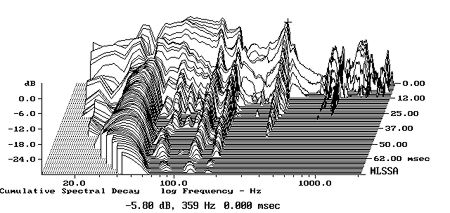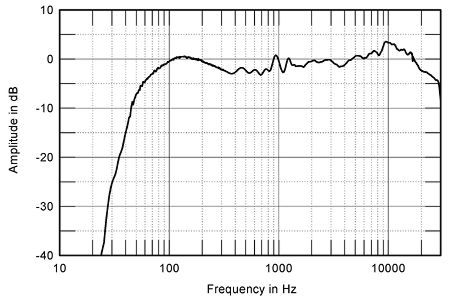| Columns Retired Columns & Blogs |
I brought home a pair of B&W 685 speakers and they didn't sound as good to me as the Polks. The highs are nicer from the Polks.
Given its diminutive size, the Polk RTi4 was surprisingly sensitive: an estimated 89.3dB(B)/2.83V/m. Its impedance magnitude (fig.1) remains above 4 ohms for almost all of the audioband, and although there is a somewhat problematic combination of 5 ohms magnitude and a -42 degrees capacitive phase angle at 150Hz, overall it will not be a difficult speaker for an amplifier to drive. The saddle at 54Hz in the magnitude trace in fig.2 suggests that this is the tuning frequency of the RTi4's two ports.

Fig.1 Polk RTi4, electrical impedance (solid) and phase (dashed). (2 ohms/vertical div.).

Fig.2 Polk RTi4, cumulative spectral-decay plot calculated from the output of an accelerometer fastened to the cabinet's side panel (MLS driving voltage to speaker, 7.55V; measurement bandwidth, 2kHz).
Though a couple of slight wrinkles in the impedance traces suggest the presence of panel resonances, these are fairly high in frequency, between 600Hz and 1kHz, minimizing the audibility of any associated coloration. However, the cabinet seemed fairly lively when I rapped it with my knuckles. Looking at the sidewall's vibrational behavior with an accelerometer revealed a fairly high-level resonant mode at 360Hz, with two other modes present between 100Hz and 200Hz (fig.2), which might contribute to the warmth noted by Bob Reina.
Fig.3 shows the farfield frequency response of the tweeter and woofer, as well as the nearfield outputs of the woofer and the front and rear ports. The crossover between the two drive-units is set as specified at 1.9kHz, though the high-pass slope is steeper than the specified second-order filter at an estimated 18dB/octave. The tweeter also shows a rising response on-axis in its passband. The woofer has a couple of small peaks apparent around 1kHz, and though its smooth low-pass rollout is slightly marred by a peak at 5kHz, this is suppressed by the crossover. Lower in frequency, the woofer's minimum-motion point lies at 54Hz, as expected from the impedance graph, implying only modest bass extension.

Fig.3 Polk RTi4, acoustic crossover on tweeter axis at 50", corrected for microphone response, with the nearfield woofer (black) and front (red) and rear (blue) port responses plotted below 350Hz and 1kHz, respectively.
The outputs of the front (red trace) and rear (blue) ports peak at the same frequency, with well-controlled rolloffs above that region. Like the Polk LSi7, which BJR reviewed for Stereophile in March 2003, the RTi4's ports feature a sharp spike just below 900Hz. This behavior is due to Polk's ARC (Acoustic Resonance Control) port tuning, which is intended to minimize the effect of an internal standing-wave resonance by vibrating at the same frequency as the standing wave, but out of phase with it. These peaks therefore look more alarming in this graph than they really are. Nevertheless, there is a small peak in the woofer's farfield output in the same frequency region.
This peak can also be seen in fig.4, which shows the RTi4's farfield response, averaged across a 30 degrees horizontal window on the tweeter axis and spliced to the complex sum of the nearfield woofer and port response. The bass rolls off smoothly below 90Hz or so, which is to be expected from such a small enclosure. However, the woofer alignment is a little boosted in the upper bass to give the impression of more low frequencies than are really there. To judge from BJR's enthusiasm for the Polk's low-frequency behavior, it would seem that this works, though the tradeoff is the warmth he also noted.

Fig.4 Polk RTi4, anechoic response on tweeter axis at 50", averaged across 30 degrees horizontal window and corrected for microphone response, with the complex sum of the nearfield woofer and port responses, taking into account acoustic phase and distance from the nominal farfield point, plotted below 300Hz.
The rising trend in the on-axis response's mid- and high trebles can also be seen in this graph, but whether or not this will be perceived as excessive highs will depend on the speaker's dispersion in the same region. Fig.5, which shows the RTi4's horizontal radiation pattern, reveals that the tweeter becomes quite directional above 8kHz or so, which will tend to ameliorate the effect of the rising treble in typically sized rooms. However, BJR did comment on the RTi4's occasional emphasis of sibilants, which probably correlates with the slight off-axis flare in this graph in the tweeter's bottom octave, as well as the on-axis rise in the top two octaves.

Fig.5 Polk RTi4, lateral response family at 50", normalized to response on tweeter axis, from back to front: differences in response 90 degrees-5 degrees off-axis, reference response, differences in response 5 degrees-90 degrees off-axis.
In the vertical plane (fig.6), suckouts in the crossover region don't develop until quite extreme off-axis angles, suggesting that the Polk will not be too fussy about exact listening height. However, high stands will probably work better than low ones.

Fig.6 Polk RTi4, vertical response family at 50", normalized to response on tweeter axis, from back to front: differences in response 45 degrees-5 degrees above axis, reference response, differences in response 5 degrees-45 degrees below axis.
Although it is specified as using second-order crossover filters, which usually require the tweeter and woofer to be connected in antiphase, the RTi4's step response (fig.7) indicates that both drive-units are connected with the same, positive acoustic polarity. This was confirmed by the step responses of the individual units (fig.8). The coincidence of the woofer's slow-rising step in this graph with the return to the time axis of the tweeter's inevitable overshoot confirms the units' excellent frequency-domain integration, as seen in fig.4. Note the slow undulations in the tail of the woofer's step. These are due to the port resonant behavior seen earlier, but, as the waterfall plot shows (fig.9), this is relatively mild, suggesting that Polk's ARC technique works as advertised. Overall, this plot reveals a superbly clean decay of the transient.

Fig.7 Polk RTi4, step response on tweeter axis at 50" (5ms time window, 30kHz bandwidth).

Fig.8 Polk RTi4, individual step responses on tweeter axis at 50" of woofer (blue) and tweeter (red). (5ms time window, 30kHz bandwidth.)

Fig.9 Polk RTi4, cumulative spectral-decay plot at 50" (0.15ms risetime).
Considering that the RTi4 costs just $320/pair, its measured performance is excellent.—John Atkinson